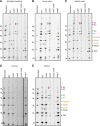Eudicot primary cell wall glucomannan is related in synthesis, structure, and function to xyloglucan
- PMID: 35929080
- PMCID: PMC9614514
- DOI: 10.1093/plcell/koac238
Eudicot primary cell wall glucomannan is related in synthesis, structure, and function to xyloglucan
Abstract
Hemicellulose polysaccharides influence assembly and properties of the plant primary cell wall (PCW), perhaps by interacting with cellulose to affect the deposition and bundling of cellulose fibrils. However, the functional differences between plant cell wall hemicelluloses such as glucomannan, xylan, and xyloglucan (XyG) remain unclear. As the most abundant hemicellulose, XyG is considered important in eudicot PCWs, but plants devoid of XyG show relatively mild phenotypes. We report here that a patterned β-galactoglucomannan (β-GGM) is widespread in eudicot PCWs and shows remarkable similarities to XyG. The sugar linkages forming the backbone and side chains of β-GGM are analogous to those that make up XyG, and moreover, these linkages are formed by glycosyltransferases from the same CAZy families. Solid-state nuclear magnetic resonance indicated that β-GGM shows low mobility in the cell wall, consistent with interaction with cellulose. Although Arabidopsis β-GGM synthesis mutants show no obvious growth defects, genetic crosses between β-GGM and XyG mutants produce exacerbated phenotypes compared with XyG mutants. These findings demonstrate a related role of these two similar but distinct classes of hemicelluloses in PCWs. This work opens avenues to study the roles of β-GGM and XyG in PCWs.
© The Author(s) 2022. Published by Oxford University Press on behalf of American Society of Plant Biologists.
Figures








Similar articles
-
The synthesis of xyloglucan, an abundant plant cell wall polysaccharide, requires CSLC function.Proc Natl Acad Sci U S A. 2020 Aug 18;117(33):20316-20324. doi: 10.1073/pnas.2007245117. Epub 2020 Jul 31. Proc Natl Acad Sci U S A. 2020. PMID: 32737163 Free PMC article.
-
Structure and dynamics of Brachypodium primary cell wall polysaccharides from two-dimensional (13)C solid-state nuclear magnetic resonance spectroscopy.Biochemistry. 2014 May 6;53(17):2840-54. doi: 10.1021/bi500231b. Epub 2014 Apr 22. Biochemistry. 2014. PMID: 24720372
-
The identification of two arabinosyltransferases from tomato reveals functional equivalency of xyloglucan side chain substituents.Plant Physiol. 2013 Sep;163(1):86-94. doi: 10.1104/pp.113.221788. Epub 2013 Jul 26. Plant Physiol. 2013. PMID: 23893172 Free PMC article.
-
Branched mannan and xyloglucan as a dynamic duo in plant cell walls.Cell Surf. 2023 Jan 25;9:100098. doi: 10.1016/j.tcsw.2023.100098. eCollection 2023 Dec. Cell Surf. 2023. PMID: 36756196 Free PMC article. Review. No abstract available.
-
Biosynthesis of the Plant Cell Wall Matrix Polysaccharide Xyloglucan.Annu Rev Plant Biol. 2016 Apr 29;67:235-59. doi: 10.1146/annurev-arplant-043015-112222. Epub 2016 Feb 29. Annu Rev Plant Biol. 2016. PMID: 26927904 Review.
Cited by
-
Time-resolved tracking of cellulose biosynthesis and assembly during cell wall regeneration in live Arabidopsis protoplasts.Sci Adv. 2025 Mar 21;11(12):eads6312. doi: 10.1126/sciadv.ads6312. Epub 2025 Mar 21. Sci Adv. 2025. PMID: 40117364 Free PMC article.
-
Differing structures of galactoglucomannan in eudicots and non-eudicot angiosperms.PLoS One. 2023 Dec 21;18(12):e0289581. doi: 10.1371/journal.pone.0289581. eCollection 2023. PLoS One. 2023. PMID: 38127933 Free PMC article.
-
A rice GT61 glycosyltransferase possesses dual activities mediating 2-O-xylosyl and 2-O-arabinosyl substitutions of xylan.Planta. 2024 Apr 8;259(5):115. doi: 10.1007/s00425-024-04396-0. Planta. 2024. PMID: 38589536
-
Glucomannan engineering highlights roles of galactosyl modification in fine-tuning cellulose-glucomannan interaction in Arabidopsis cell walls.Nat Commun. 2025 Jan 31;16(1):1235. doi: 10.1038/s41467-025-56626-y. Nat Commun. 2025. PMID: 39890794 Free PMC article.
-
Cell walls: a comparative view of the composition of cell surfaces of plants, algae, and microorganisms.J Exp Bot. 2025 Jul 2;76(10):2614-2645. doi: 10.1093/jxb/erae512. J Exp Bot. 2025. PMID: 39705009 Free PMC article. Review.
References
-
- Altschul SF, Gish W, Miller W, Myers EW, Lipman DJ (1990) Basic local alignment search tool. J Mol Biol 215: 403–410 - PubMed
-
- Aryal B, Jonsson K, Baral A, Sancho-Andres G, Routier-Kierzkowska AL, Kierzkowski D, Bhalerao RP (2020) Interplay between cell wall and auxin mediates the control of differential cell elongation during apical hook development. Curr Biol 30: 1733–1739 - PubMed
-
- Benselfelt T, Cranston ED, Ondaral S, Johansson E, Brumer H, Rutland MW, Wågberg L (2016) Adsorption of xyloglucan onto cellulose surfaces of different morphologies: an entropy-driven process. Biomacromolecules 17: 2801–2811 - PubMed
Publication types
MeSH terms
Substances
Grants and funding
LinkOut - more resources
Full Text Sources
Molecular Biology Databases
Research Materials

